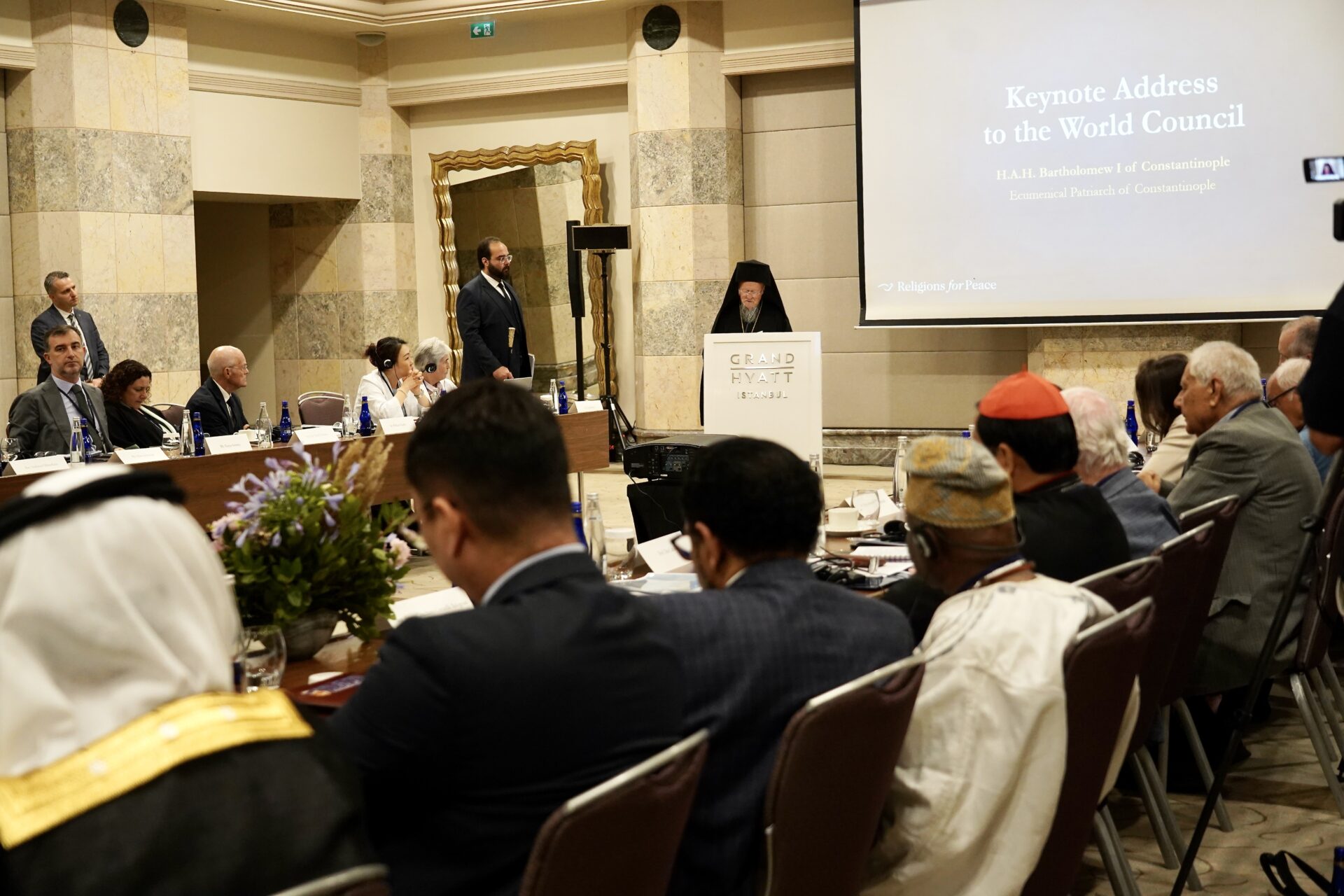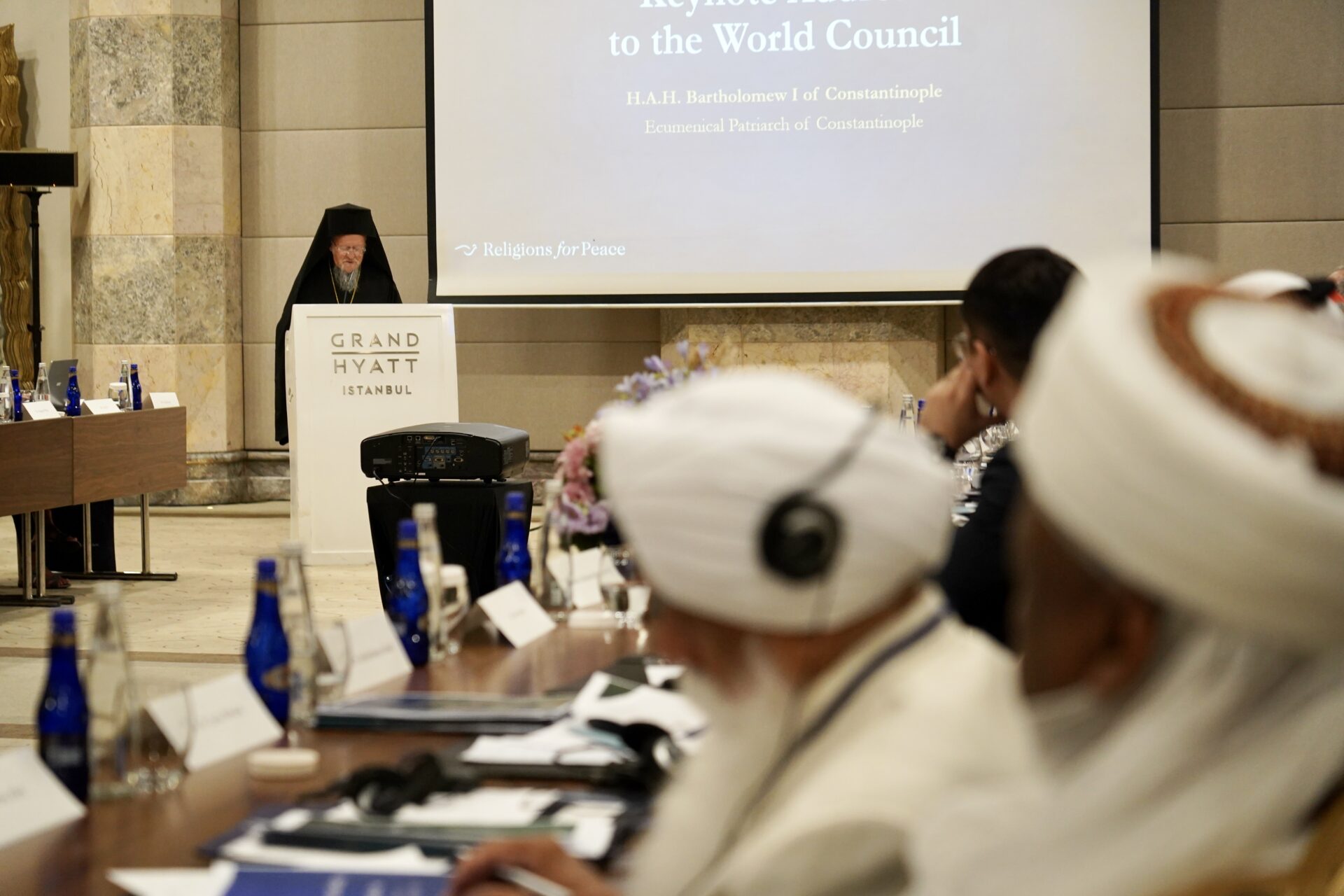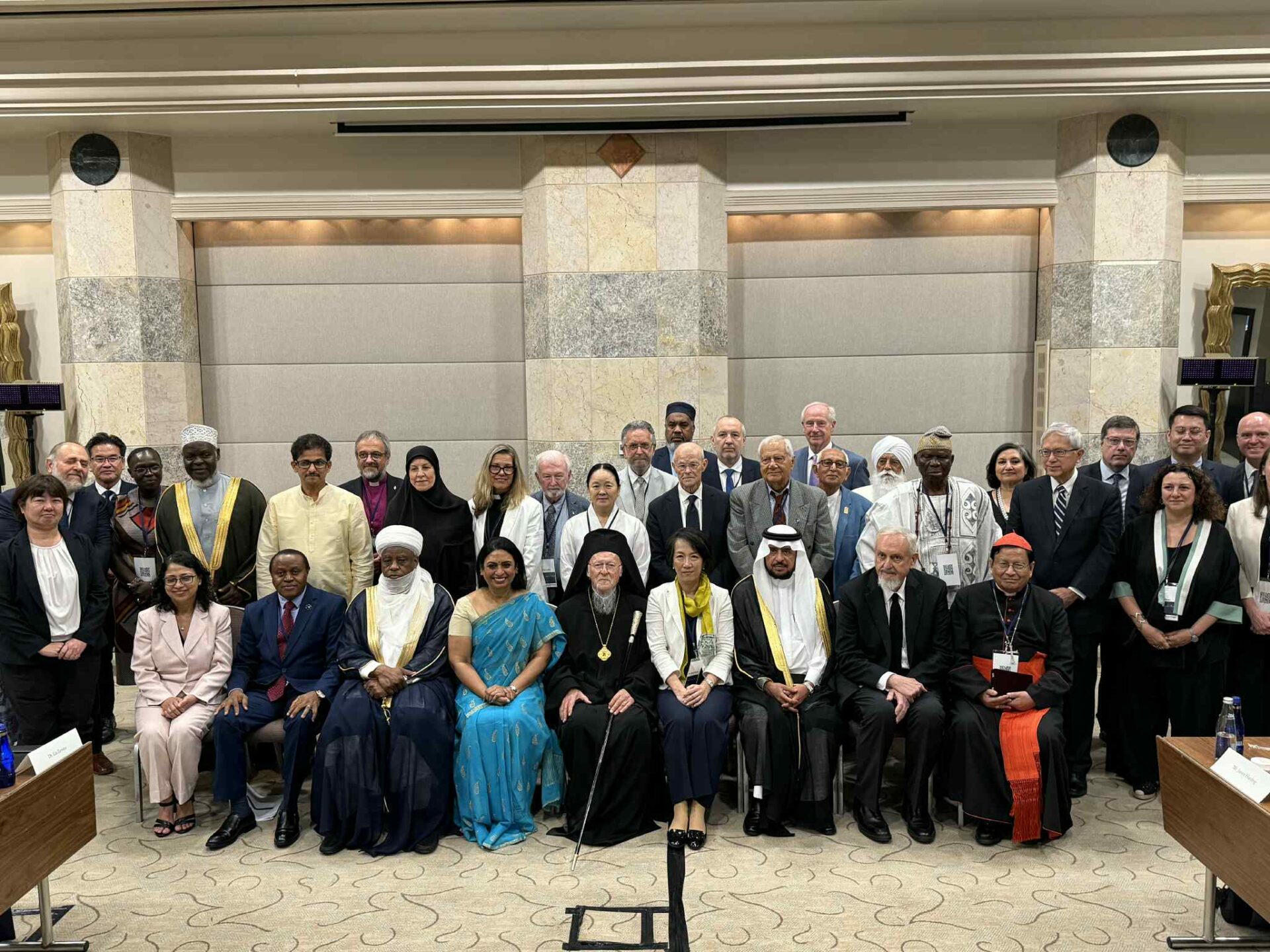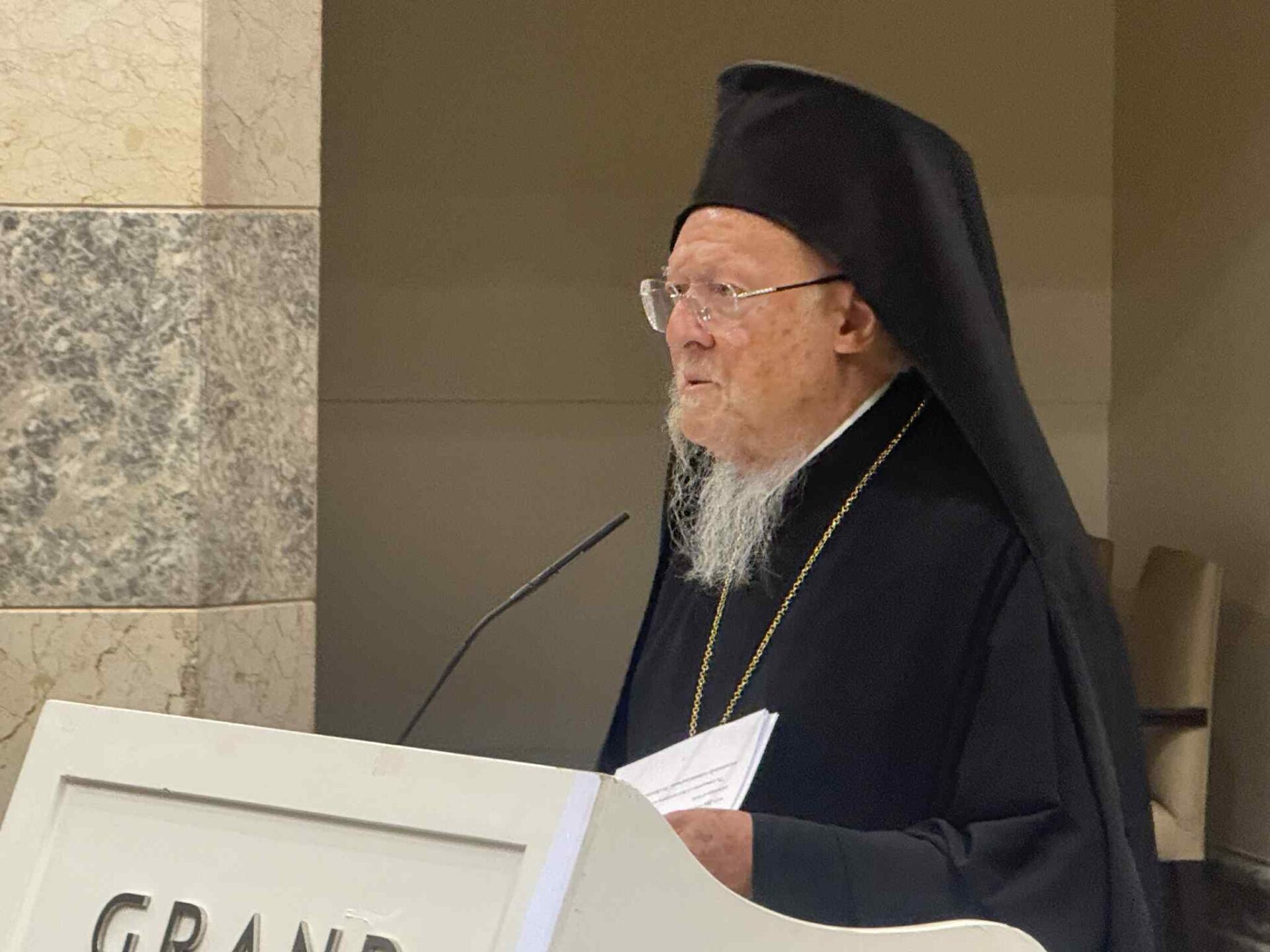ΟΙΚΟΥΜΕΝΙΚΟΝ ΠΑΤΡΙΑΡΧΕΙΟΝ
Η Α.Θ. Παναγιότης ο Οικουμενικός Πατριάρχης κ.κ. Βαρθολομαίος κήρυξε την Τρίτη, 29 Ιουλίου, το πρωί, την έναρξη των εργασιών του Παγκοσμίου Συμβουλίου “Θρησκείες για την ειρήνη”, που διεξάγεται στην Πόλη, το διήμερο 29-30 Ιουλίου 2025 και συμμετέχουν σε αυτό περισσότεροι από 60 θρησκευτικοί ηγέτες από όλο τον κόσμο.
Στην ομιλία του, με τίτλο “Αντιθέσεις και προαπαιτούμενα του Διαθρησκειακού Διαλόγου”, αναφέρθηκε στην αξία και τη σημασία που έχει ο διαθρησκειακός διάλογος, ιδιαίτερα σε μία εποχή όπου κυριαρχούν η οικονομία και η τεχνολογία.
“Η συνάντηση των διαφορετικών θρησκευτικών παραδόσεων, καθεμία από τις οποίες φέρει μια μοναδική εμπειρία του Ιερού, γίνεται η απαραίτητη προϋπόθεση για την αντιπαράθεση με μια παγκοσμιοποιημένη έλλειψη νοήματος, για την επαναδιατύπωση ενός λόγου που τολμά να μιλήσει για την αγάπη, τη συμπόνια, το έλεος, τη συγχώρεση και την αυτοθυσία, όχι ως αφηρημένες ηθικές αξίες, αλλά ως ενεργά στοιχεία μιας πληρέστερης πραγματικότητας”, επεσήμανε, μεταξύ άλλων, ο Πατριάρχης, ο οποίος μίλησε στην αγγλική γλώσσα.
Σε άλλο σημείο της ομιλίας του υπογράμμισε:
“H χριστιανική μαρτυρία προσφέρει σε αυτόν τον διάλογο μια προοπτική που δεν επιδιώκει να κυριαρχήσει, αλλά να υπηρετήσει: την εικόνα του Θεού ως κοινωνία Προσώπων, ως αιώνια σχέση αγάπης. Η ειρήνη, υπό αυτό το πρίσμα, δεν είναι μια στατική κατάσταση ισορροπίας, αλλά μια δυναμική, εσχατολογική πραγματικότητα – η προσδοκία μιας τελικής συμφιλίωσης των πάντων εν Χριστώ. Η κοινή δράση των θρησκειών, επομένως, αντλεί το βαθύτερο νόημά της όχι από μια υπάρχουσα συμφωνία, αλλά από μια κοινή ελπίδα για ένα μελλοντικό κόσμο δικαιοσύνης και αγάπης.
Δεν καλούμαστε, επομένως, να συνθέσουμε μια νέα παγκόσμια θρησκεία συναίνεσης. Καλούμαστε, ο καθένας από την άποψη της πίστης του, να συγκροτήσουμε μια παγκόσμια συμμαχία συνείδησης, μια προφητική μαρτυρία που θα κρατήσει ανοιχτό τον ορίζοντα της υπέρβασης σε ένα κόσμο που απειλείται με ασφυξία μέσα στα όρια του υλικού. Η ενότητά μας δεν βασίζεται σε αυτό που πιστεύουμε από κοινού, αλλά στην κοινή μας αγάπη για την ανθρωπότητα και στην κοινή μας αναφορά στο μυστήριο του ενός Θεού. Αυτή είναι η μόνη βιώσιμη ειρήνη.

Keynote Address by His All-Holiness Ecumenical Patriarch Bartholomew at the Meeting of the World Council of Religions for Peace (Istanbul, July 29, 2025)
“Contradictions and Prerequisites of Interreligious Dialogue”
Your Eminences,
Your Excellencies,
Mr. Secretary General,
Distinguished members of the World Council,
Dear friends and colleagues,

In this City, whose stones still bear the echo of centuries where the oecumene was defined not as a geographical expanse but as a spiritual horizon, and where the Ecumenical Patriarchate of Constantinople continues to bear witness to the universal calling of Orthodox Christianity, a contemporary conscience convenes to confront a situation of planetary crisis. The challenge, however, is not located primarily in its visible manifestations, in the economic instability that transforms into the asphyxiation of entire peoples, in the unbridled technological progress that places under question the very concept of human agency, but in something deeper, in an underlying condition that permits these phenomena to manifest with such destructive intensity. The diagnosis, as it is articulated in the context of the initiative “Religions for Peace,” recognizes as a fundamental problem a dominant, usually unavowed, worldview. It concerns a prevailing materialism with a character of reductive simplification, a way of viewing the real that contracts human flourishing to its material dimension, systematically excluding any reference to the Sacred. This need to transcend matter in order to approach truth constitutes the central core of our spiritual tradition. As the Great Cappadocian Father of the Church, Saint Gregory of Nyssa, teaches, it is impossible for anyone to ascend to that height where the light of truth is seen, unless the dead and earthly garment of skins is stripped away from the foundations of the soul… This is truly that which really exists, and the understanding of this is the knowledge of truth.
The consequence of this worldview is not simply philosophical; it is profoundly existential and social. The Distortion of the concept of human completeness promotes isolation, exploitation and environmental destruction. Man ceases to be conceived as a relational being, founded on a transcendent reality, and is converted into an autonomous unit that claims its well-being at the expense of others and of the natural world. The loss of the relationship with the Sacred translates into a loss of the bonds that constitute society, leaving behind it a sum of individuals in competition. Within this landscape of spiritual desolation, interreligious dialogue emerges not simply as a theological preoccupation or a luxury of peaceful times, but as an inexorable necessity, as an act of collective resistance. The encounter of the different religious traditions, each one a bearer of a unique experience of the Sacred, becomes the necessary condition for the confrontation with a globalised meaninglessness, for the re-articulation of a discourse that dares to speak of love, compassion, mercy, forgiveness and self-sacrifice not as abstract moral values, but as active elements of a fuller reality. The need for common action, as expressed from the beginning of the movement “Different Faiths – Common Action,” presupposes a common meeting place, a ground where the individual voices can articulate a common testimony.
The answer that is proposed to this existential challenge takes the form of an ambitious intellectual edifice: that of the “Common Sacred Worldview,” a framework that aspires to function as the theoretical foundation for a “Common Sacred Flourishing.” This is not an attempt to create a new, syncretistic religion, nor a substitution for the unique worldviews that characterise each religious tradition. Its purpose is, on the contrary, the highlighting of a field of consensus, the mapping of those points where the different experiences of the Sacred converge, creating a common front against the dominion of materialistic reductionism. The intention is to render explicit a connection with the Sacred, which previously remained silent in interreligious initiatives, simultaneously allowing each tradition to preserve its distinct identity.
This framework is articulated around four fundamental pillars, which constitute a holistic view of reality. At the centre lies the Sacred itself, the ultimate, absolute reality, which is expressed in various ways, as God, Allah, Brahman or as the Luminous Void. This reality is not an abstract principle, but the foundation of the “community of being,” which unites all things through Love, Compassion, Mercy. Secondly, human beings are conceived as by definition relational beings, precisely because they are founded on the Sacred. Their potential for completeness is not exhausted in the protection of rights, but is actualised through the cultivation of virtues, with the freedom that springs from Sacred Love being central. Thirdly, society is not a simple sum of individuals, but a “whole of whole human beings,” a structure of reciprocity between persons and the institutions of the common good family, education, economy. Finally, the Earth and the network of its life, regardless of whether they are considered sacred in themselves or expressions of the Sacred, are recognised by all traditions as founded on the Sacred, demanding a respect that is expressed through virtues such as sustainable consumption and structures such as renewable energy sources.
The power of this proposal lies in its attempt to bridge the chasm between faith and science. Drawing from the modern discoveries of quantum mechanics and biology, it challenges the dominant mechanistic models of the universe, projecting instead an image of purposefulness and interconnected wholeness that coordinates with the spiritual perspectives. The invitation for a “new natural philosophy” that unites the scientific and the spiritual quest constitutes perhaps the boldest element of the enterprise. The “Common Sacred Flourishing,” therefore, is not simply a theoretical conception, but a guide for collaborative action, a framework that seeks to supplement even the Sustainable Development Goals of the United Nations, adding the critical dimension of man’s relationship with the Sacred, a dimension that is often absent from purely secular designs. The success, however, of such ambitious theoretical frameworks depends upon a fundamental precondition. As scholars have observed, referring to the dynamic of interreligious encounters, there is the importance of the dialogue of life as a precondition for interreligious dialogue. Before the convergence of dogmas, the communion of lived experiences precedes; before the common worldview, the common path.
The situation which the “Common Sacred Worldview” is called to confront is not a merely contemporary pathology. Humanity lives within a pluralistic framework from the beginning of its recorded history. The perplexity before this fact is fundamental: why does homo sapiens, whose biochemical texture and genetic potential are essentially common, whose fine furrows of the cortex are kindred in all peoples, not speak a common language? Why, instead of a single linguistic solution that would seem absolutely comprehensible in the light of the anatomical and neurophysiological universalities, are we confronted with four or five thousand languages in use, a remnant of an even greater number that were spoken in the past? This “motley quilt,” this “mad variety” constitutes not merely a technical impediment to communication, but a powerful obstacle to the material and social progress of the species, a source of hatred and mutual contempt that is born from the inability of mutual understanding.

The mythological consciousness of every culture has its own version of Babel, its own narrative for the primordial dispersal of languages. Whether as a punishment for a hubristic act, a maddened tower that was launched towards the stars, or as an accidental release of a linguistic chaos, the condition of multilingualism is experienced as a second Fall. Man was exiled not only from the Garden, but also from the unified family of man, from the certainty that he can conceive and communicate reality. The memory of a primeval, Adamic dialect, which permitted a perfect correspondence between words and things, of a language where the giving of names was a representation of the very creative act of God, haunts human thought as a lost unity. The history of human linguistic consciousness, from this perspective, is nothing but the laborious oscillation of the pendulum between Babel and a return to homophony, to a messianic moment of restored understanding.
At this exact point, the contemporary proposal for a “Common Sacred Worldview” meets the ancient mythic quest. It can be seen as a secularised, logically processed attempt to reverse the curse of Babel, no longer in the field of common language, but in that of common spiritual reference. The polyphony of religions, just like multilingualism, is presented as an obstacle that must be overcome, as a source of confusion that favours the prevalence of a non-religious materialism. The “Common Sacred Worldview” aspires to function as a grammatica universalis of the sacred, a system of “deep structure” where the superficial differences of the religious “languages” are reduced to common, fundamental principles. The intention is the creation of a meta-linguistic system of reference, of a meeting place that will permit the “translation” of the individual sacred truths into a commonly understood terminology, capable of articulating speech towards the contemporary world. It is an attempt to rebuild a tower, no longer of bricks and asphalt, but of common concepts and mutually accepted principles, a tower that does not aim at the conquest of heaven, but at the protection of the earth from its absence. The noble ambition of this enterprise is indisputable, just as indisputable is also the agony from which it springs. However, the very analogy with the enigma of Babel gives birth to a critical question: might multiplicity not be simply a curse that must be lifted, but a condition that encloses a deeper, perhaps even necessary, function? Might the vitality of the human spirit have been preserved precisely because it was dispersed amongst the languages? The answer to this question will determine not only the applicability, but also the very essence of every effort for a common view of the Sacred. Because the construction of a new unity presupposes the understanding of the reasons for which the old one was lost, and whether it was indeed lost or simply transformed into a more complex, more demanding form of communion.
The failure to establish a common conceptual starting point for the Sacred does not nullify the necessity of dialogue; on the contrary, it renders it more pertinent, shifting the centre of gravity from the space of theoretical agreement to the field of common historical responsibility. Because, if the religious traditions find it difficult to meet at the high level of their dogmatic truths, they are obliged to meet in the field of earthly reality, there where the consequences of a de-sacralised world are manifested as specific pain, as collective illness, as a rupture of the social fabric. The crisis of modernity is not an abstract philosophical condition. It is a tangible reality that takes on flesh and bones in two, seemingly unconnected between them, but profoundly related phenomena that haunt the global community: the unliftable weight of global debt and the uncontrolled emergence of artificial intelligence. These are not simply technical problems that demand technocratic solutions; they are the symptoms of a deep spiritual pathology, the phantoms that the earthly city gives birth to when it attempts to build itself in God’s absence.
The global debt crisis, especially in low- and middle-income countries, constitutes the most manifest expression of an economy that has lost all moral foundation. Behind the impersonal numbers and the complex financial products, is hidden an archaic reality of slavery. Entire peoples are rendered serfs of an abstract mechanism, which, based on structural injustices and exploitative lending systems, drains their wealth, stifles their development and mortgages their future. Here, the reductionist materialistic worldview finds its most perfect application: man ceases to be considered as a person, as an image of God, and is transformed into a unit of production and consumption, into a number on the balance sheet of an unseen creditor. The economic relationship, which could be a field of solidarity and mutual support, a function of communion of goods, is distorted into a relationship of domination that denies the very dignity of man.
That which the Scriptures call the worship of Mammon is not simply avarice; it is the subjugation of the entire existence to an abstract power that demands absolute faith and sacrifices. You cannot serve both God and money (Matthew 6:24). The global debt is the modern, institutionalised form of this idolatry. It is a system that produces and reproduces inequality, preventing the poorer societies from investing in their health, education and their infrastructure, rendering them eternally vulnerable to every new crisis. Its confrontation cannot be restricted to accounting arrangements, to restructurings and ‘haircuts.’ It requires a radical moral reappraisal, a return to the principles of justice and solidarity that all our religious traditions teach. It requires the recognition that there are debts that are morally illicit, that the concept of remission, of the Jubilee, is not a pious utopia, but a precondition for the survival of the human community.
If debt constitutes the material manifestation of inhumanity, artificial intelligence (AI) emerges as its digital phantom. Here the challenge is more subtle, more pervasive, and potentially existentially deeper. Artificial intelligence is not simply a new tool; it is the creation of a semblance of human reason, of an intelligence disconnected from consciousness, the body and the spirit. While it promises unprecedented advancements in medicine, education and security, it raises simultaneously urgent ethical questions concerning prejudice, surveillance, inequality and the erosion of human agency. The algorithms, trained on data that reflect existing social injustices, are in danger of consolidating and reinforcing them, creating an invisible, but omnipotent, web of control that determines who has access to opportunities and who is excluded. Human judgement, with its nuances, its intuition and its compassion, is in danger of being replaced by the cold efficiency of the machine.

The deeper challenge of artificial intelligence, however, concerns the very image of man. The reductionist view that regards man as a complex biochemical computer finds in artificial intelligence its final justification. If thought is simply data processing, then the machine can indeed surpass its creator. In this perspective, the unique, unrepeatable and infinitely valuable person, that which Christian theology perceives as the “in the image,” shrinks into a set of data, into a predictable pattern of behaviour. Freedom, creativity, love, prayer, all these expressions of human uniqueness, are stripped of their mystery and are analysed as neural processes. Humanity is in danger of losing not only the control of its tools, but the very sense of what it means to be human.
Both global debt and artificial intelligence, despite their different appearance, spring from the same philosophical root: the apotheosis of abstraction and of utility. In the case of debt, the abstraction is money, severed from the real economy, which ignores the person of the debtor. In the case of artificial intelligence, the abstraction is the data, which ignore the uniqueness of the subject. And in both cases, the logic of utility, the pursuit of maximum performance, whether economic or computational, prevails over every other value. This constitutes the deeper problem, the ideological core that must be confronted. As has been observed, the dialogue must be conducted “with the religious core of a cultural encounter or with its ideological core, as in the case of secular culture.” The ideological core of contemporary secular culture is precisely this faith in the omnipotence of abstraction.
The response of the religious communities cannot, therefore, be defensive or negative. The denunciation of the dangers does not suffice. What is required is the projection of an alternative, positive view of man and of society, a view rooted in the conviction that human beings are ‘relational beings’ and society a ‘relational whole.’ Against the abstraction of debt, the religions ought to counterpose the concrete reality of solidarity – the practice of justice, the demand for transparency and moral accountability in global economic affairs. Against the abstraction of artificial intelligence, they ought to defend the inestimable value of the person, the sanctity of consciousness and the inviolability of freedom. The development of an ethics for technology, founded on the values of compassion, responsibility and dignity, is one of the most urgent duties of our era.
These two fronts, the economic and the technological, reveal the bankruptcy of a purely secular conception of progress. They compel us to return to fundamental questions that modernity tried to ignore: What is man? What constitutes a just society? What is the meaning of human existence? To these questions, the technical solutions and the economic prescriptions are silent. The word belongs to the great spiritual and religious traditions of humanity, which are called not to give ready-made answers, but to open anew the horizon of wisdom, of contemplation and of prayer. The failure of the earthly city to find happiness in abstraction reveals its unconquerable thirst for communion.

The analysis of the specific challenges, of debt and of artificial intelligence, brings us back to the initial question, but with new terms. If the starting-point of a “common sacred perspective” proves philosophically precarious, and if the secular city fails to offer meaning and communion, where ultimately is the meeting place of the world’s religions to be found? The answer lies not in the achievement of a conceptual consensus, but in the acceptance of a common mission: that of testimony. Each religious tradition is called to testify, from the heart of its own revelatory experience, against the nihilism of the age, offering as an antidote not a general spirituality, but the wealth of its own, unrepeatable otherness.
The true basis for common action is not the convergence on a theory, but the journeying-together in a deed. This truth is captured in the emphasis on the importance of the “dialogue of life as a precondition for interreligious dialogue.” We meet in essence not when our theologies coincide, but when our communities share bread with the hungry, care for the sick, defend the wronged. Unity is forged in the common resistance to the forces that attempt to efface the human face. In this struggle, the diversity of our spiritual weapons is not a weakness, but a wealth.
The Christian testimony, more specifically, offers to this dialogue a perspective that does not seek to dominate, but to serve: the image of God as a communion of Persons, as an eternal relationship of love. Peace, under this prism, is not a static state of equilibrium, but a dynamic, eschatological reality – the expectation of a final reconciliation of all things in Christ. The common action of the religions, therefore, draws its deepest meaning not from an existing agreement, but from a common hope for a future world of justice and love.
We are not called, therefore, to compose a new global religion of consensus. We are called, each from the standpoint of his faith, to constitute a global alliance of conscience, a prophetic testimony that will keep open the horizon of transcendence in a world threatened with asphyxiation within the confines of the material. Our unity is not founded on what we believe in common, but on our common love for humanity and on our common reference to the mystery of the one God. This is the only viable peace.
Thank you all for your kind attention.
photos: Nikos Papachristou



